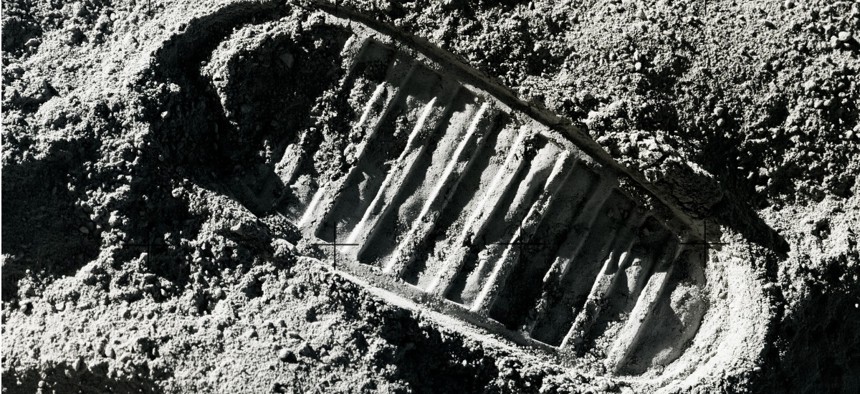How 3D Printing with Moonrock-Like Material Could Lead to New Space Habitats

stevecoleimages/iStock.com
New research could also mark a milestone for a sophisticated device that already resides beyond Earth.
Instruments for a future-facing experiment to demonstrate 3D printing—in space, using material simulating dust found on the moon or other planetary bodies—are set to go to the International Space Station from Virginia on Northrop Grumman’s 16th commercial resupply mission for NASA next month.
Through the Redwire Regolith Print study, researchers will test the feasibility of using onsite, space-based raw resources to build on-demand landing pads, habitats and more during future exploration missions.
Regolith refers to the blanket of loose rocks and soil on a solid surface—Earth, or elsewhere.
“It will be the first time 3D printing with a regolith material has been demonstrated in microgravity,” Redwire Aerospace Engineer Howie Schulman told Nextgov in an email Friday. “I view it as game-changing because it is the necessary stepping stone to finally creating the flight-ready construction equipment that will enable our continuous habitation on the lunar surface.”
Schulman is a project lead on the effort. He explained that NASA fostered the development of regolith 3D printing by hosting a centennial challenge for additively manufacturing habitats, which kicked off in 2015. The space agency has since continued to invest in this research and development as it supports the long-term goals of the Artemis program—namely, maintaining a continued human presence on the lunar surface.
“This study was spurred by the need to build the large pieces of infrastructure on the moon necessary for permanent settlement,” Schulman said.
Through the project, researchers aim to prove and assess 3D printing with a regolith-laden simulant material in a place with continuous microgravity. The material to be used in the experiment is a “specially developed feedstock optimized for compressive strength,” according to Schulman. It’s composed of a polymer binder and the lunar regolith simulant JSC-1A.
Schulman confirmed that “NASA preferred this specific regolith simulant and provided it to Redwire for use on the mission.”
Three prints are anticipated to be performed in the experiment, and each will produce a unique solid slab. Those slabs will then be downmassed and delivered to NASA scientists who will study the 3D-printed materials. Some of the hardware used to complete the 3D prints will also come back to humans’ home planet for review. One objective of the on-orbit prints, Schulman noted, is to demonstrate the efficacy of the experimental manufacturing process.
A manufacturing device produced by Redwire-owned company Made In Space is already aboard the ISS and will perform much of the needed capabilities, NASA’s site notes. Extruders and printbeds made explicitly for regolith-based materials will be integrated with that advanced printer.
“The RRP mission is sending experimental swappable parts for use inside the Additive Manufacturing Facility, the first commercial 3D printer to operate in space,” Schulman further explained. This space printer was “designed with future experiments in mind” and built to have modularity specifically so that it could serve as an on-orbit testbed for new manufacturing technology development.
“When ISS crew install the regolith printing modules, it will be the first time AMF is used to perform novel manufacturing technology research in space other than the original type of 3D printing it was configured for on launch,” he said. “This is a milestone for the printer, and hopefully the first of many new manufacturing research campaigns.”
On Earth, 3D printing with regolith simulant does occur. Still, the technology readiness level must rise to progress technique toward deployment on the lunar surface, Schulman noted. And by performing this demonstration in a microgravity environment, he added, “confidence will be raised that the concept is feasible for environments with gravities weaker than Earth's, particularly the moon and Mars.”
NASA has big plans to explore new realms of both of those places in the near term, and this research could help make sense of building quick structures with resources on the ground—when that time comes.
Expanding on what this research could ultimately pave the way for down the line, Schulman said Redwire views landing pads and roads as some of the “starting pieces of infrastructure” needed to enable more advanced construction around in-space environments.
“Once a lunar outpost has a solid, level touchdown site and roads to transport supplies to and from that landing site, more heavy machinery can be delivered,” he added. “Therefore, landing pads and roads will be among the first utilities to be printed by the pioneer manufacturing devices.”
Those landing pads will be designed to support the weight of large-scale landers while also managing rocket exhaust to minimize dust disturbance. Once the transportation infrastructure is in place, Schulman added, printing machines can be delivered and deployed throughout a planned outpost to create structural foundations, walls and support pillars.
“These types of installations will be used to set up solar panel grids, fuel and oxygen tank farms, and habitats,” he said.






